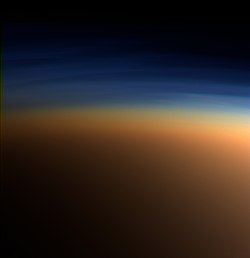 True-color image of layers of haze in Titan's atmosphere | |
| General information[2] | |
|---|---|
| Average surface pressure | 1.5 bars (147 kPa)[1] |
| Chemical species | Molar fraction |
| Composition[2] | |
| Nitrogen | 94.2% |
| Methane | 5.65% |
| Hydrogen | 0.099% |
| Argon | 0.0043%[3] |
The atmosphere of Titan is the dense layer of gases surrounding Titan, the largest moon of Saturn. Titan is the only natural satellite of a planet in the Solar System with an atmosphere that is denser than the atmosphere of Earth and is one of two moons with an atmosphere significant enough to drive weather (the other being the atmosphere of Triton).[4] Titan's lower atmosphere is primarily composed of nitrogen (94.2%), methane (5.65%), and hydrogen (0.099%).[2] There are trace amounts of other hydrocarbons, such as ethane, diacetylene, methylacetylene, acetylene, propane, PAHs[5] and of other gases, such as cyanoacetylene, hydrogen cyanide, carbon dioxide, carbon monoxide, cyanogen, acetonitrile, argon and helium.[3] The isotopic study of nitrogen isotopes ratio also suggests acetonitrile may be present in quantities exceeding hydrogen cyanide and cyanoacetylene.[6] The surface pressure is about 50% higher than on Earth at 1.5 bars (147 kPa)[1] which is near the triple point of methane and allows there to be gaseous methane in the atmosphere and liquid methane on the surface.[7] The orange color as seen from space is produced by other more complex chemicals in small quantities, possibly tholins, tar-like organic precipitates.[8]
- ^ a b Lindal, G. F.; Wood, G. E.; Hotz, H. B.; Sweetnam, D. N.; Eshleman, V. R.; Tyler, G. L. (1983-02-01). "The atmosphere of Titan: An analysis of the Voyager 1 radio occultation measurements". Icarus. 53 (2): 348–363. Bibcode:1983Icar...53..348L. doi:10.1016/0019-1035(83)90155-0. ISSN 0019-1035.
- ^ a b c Catling, David C.; Kasting, James F. (10 May 2017). Atmospheric Evolution on Inhabited and Lifeless Worlds (1 ed.). Cambridge University Press. ISBN 978-0-521-84412-3.
- ^ a b Niemann, H. B.; et al. (2005). "The abundances of constituents of Titan's atmosphere from the GCMS instrument on the Huygens probe" (PDF). Nature. 438 (7069): 779–784. Bibcode:2005Natur.438..779N. doi:10.1038/nature04122. hdl:2027.42/62703. PMID 16319830. S2CID 4344046.
- ^ Ingersoll, Andrew P. (1990). "Dynamics of Triton's atmosphere". Nature. 344 (6264): 315–317. Bibcode:1990Natur.344..315I. doi:10.1038/344315a0. S2CID 4250378.
- ^ Cours, T.; Cordier, D.; Seignovert, B.; Maltagliati, L.; Biennier, L. (2020). "The 3.4μm absorption in Titan's stratosphere: Contribution of ethane, propane, butane and complex hydrogenated organics". Icarus. 339: 113571. arXiv:2001.02791. Bibcode:2020Icar..33913571C. doi:10.1016/j.icarus.2019.113571. S2CID 210116807.
- ^ Iino, Takahiro; Sagawa, Hideo; Tsukagoshi, Takashi (2020). "14N/15N isotopic ratio in CH3CN of Titan's atmosphere measured with ALMA". The Astrophysical Journal. 890 (2): 95. arXiv:2001.01484. Bibcode:2020ApJ...890...95I. doi:10.3847/1538-4357/ab66b0. S2CID 210023743.
- ^ Horst, Sarah (2017). "Titan's Atmosphere and Climate". J. Geophys. Res. Planets. 122 (3): 432–482. arXiv:1702.08611. Bibcode:2017JGRE..122..432H. doi:10.1002/2016JE005240. S2CID 119482985.
- ^ Baez, John (January 25, 2005). "This Week's Finds in Mathematical Physics". University of California, Riverside. Archived from the original on 2012-02-08. Retrieved 2007-08-22.